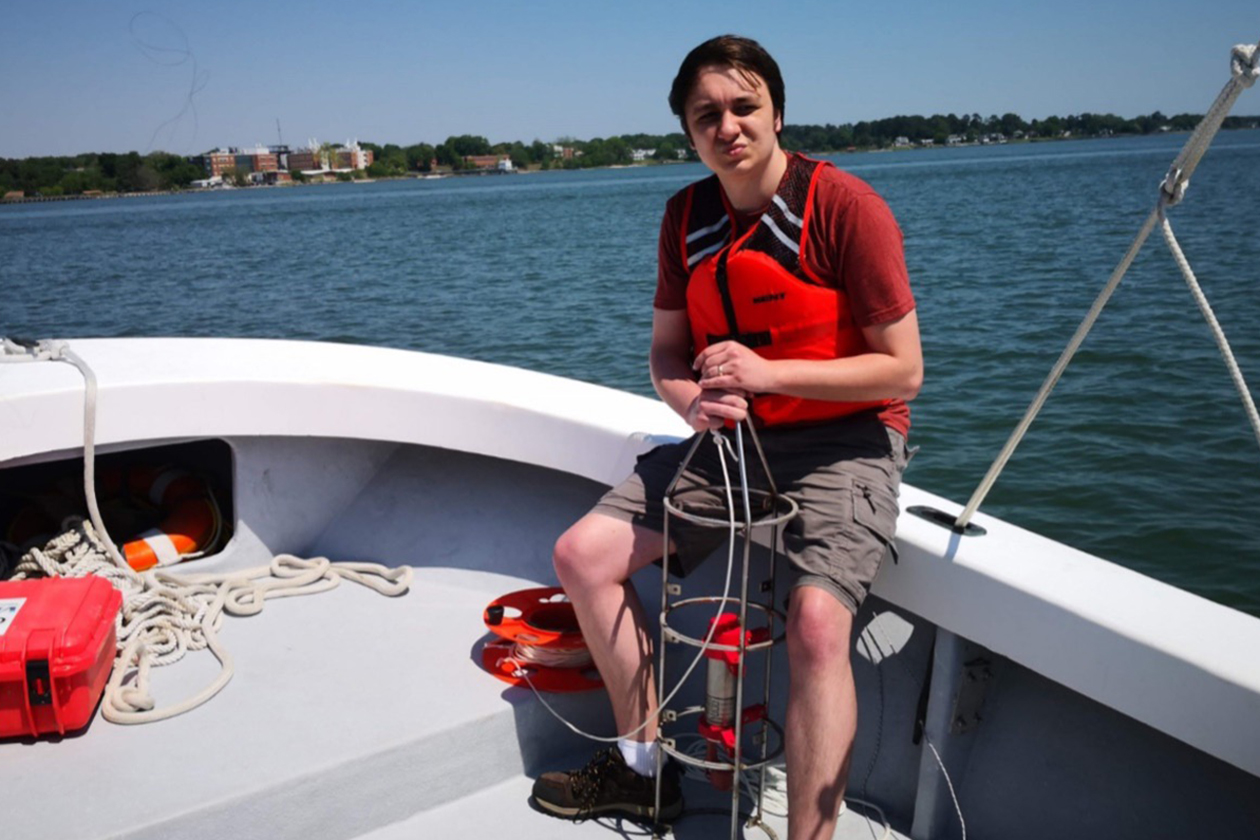
Published in the prestigious Journal of Geophysical Research: Oceans, from William & Mary’s Virginia Institute of Marine Science (VIMS) leverages more than three decades of data to demonstrate that extreme water temperatures associated with marine heatwaves last longer than previously known, exhibit subsurface seasonal patterns and are associated with the expansion of hypoxic zones.
Led by School of Marine Science Ph.D. student Nathan Shunk, the new study builds on 2022 research conducted by Piero Mazzini and Cassia Pianca that resulted in the first comprehensive study of climatological aspects of marine heatwaves in the Chesapeake Bay. Like Mazzini’s and Pianca’s work, these new findings have implications for management decisions in the Chesapeake Bay and beyond.
A dearth of data that is both at the right frequency and over a long enough period means that little is known globally about temperatures below the water’s surface during marine heatwaves. For this study, Shunk and his co-authors Mazzini and Ryan K. Walter (Cal Poly) explored data combined from three different monitoring programs in the Chesapeake Bay — the , the and the — covering a period from 1986 to 2021.
Subsurface temperature data and other variables such as dissolved oxygen, available through the , allowed the team to identify subsurface anomaly profiles during marine heatwave events. Ultimately, they identified approximately 760 marine heatwave vertical profiles for use in their analysis.
“First of all, this study would not have been possible without thirty years of steadfast efforts by the various monitoring programs that collected the data we explored. So, I would like to thank the researchers and staff that make the use of these datasets possible,” said Shunk. “The most surprising aspect of this analysis was that warming reached the bottom during the winter. We expected the effects of these events to be limited to the surface, like we found in the summer.”
Seasonal variation in the subsurface during marine heatwaves
The research shows that marine heatwave events have very different impacts in the subsurface depending on the season. Two regimes are documented: a “Homogeneous Season” and a “Stratified Season.” During the “Homogeneous Season,” taking place in the fall and winter, warming during marine heatwaves occurs throughout the entire water column, influencing bottom organisms. During marine heatwaves in the spring and summer “Stratified Season,” on the other hand, warming is only seen in the near-surface and not the bottom.

Mean monthly temperature anomalies during marine heatwave events.
The stratification (density contrast) of the water column inherent to spring and summer in the Chesapeake Bay serves to insulate the bottom from extreme conditions, perhaps protecting organisms from exceeding their temperature tolerances. Weak stratification in the fall and winter, conversely, allows the heat to penetrate all the way to the bottom during marine heatwaves.
“It’s impressive how small changes in density that we see throughout the year can determine how deep marine heatwaves can penetrate,” said Shunk. “The slight increase in stratification (density contrast) in the summer acts as a blanket, blocking the downward reach of the marine heatwaves and therefore protecting the bottom from extreme heat. As we expect to see marine heatwaves becoming more frequent as a result of climate change, it is crucial to understand their behavior in the Chesapeake Bay.”
Though temperatures are unlikely to exceed an organism’s temperature tolerance and cause mortality during this time, elevated temperatures could still effect the behavior of organisms. Blue crabs are one example of an organism that could be impacted by this phenomenon. Marine heatwave temperature patterns could disrupt their migration patterns by initiating them early or by delaying them during the fall and winter when marine heatwave temperature anomalies are greater and present throughout the water column.

Graphical representation of seasonal variation in the subsurface during marine heatwaves.
Before this study, marine heatwaves were thought to last about 11 days in the Chesapeake Bay, yet this research showed that surface temperatures are usually elevated months prior to and after the marine heatwaves, and days to weeks before and after marine heatwaves in the subsurface. Future studies related to heat stress in the environment should carefully consider the full duration of elevated temperatures.
Dead zones: a more complex picture
When it comes to oxygen distribution, the findings paint a more complex picture. This phenomenon doesn’t happen only in the vertical, as depth changes, but also varies spatially across the Chesapeake Bay. While warming was seen across the entire length of the Bay, oxygen decreases were seen primarily in the deep channel. During marine heatwaves, dissolved oxygen concentrations decreased, meaning there was less oxygen in the water, with the greatest decreases occurring in the winter and spring. In most instances from April through October, these decreases were associated with an expansion of the hypoxic region of the Bay found in the deep channel of the Chesapeake Bay main stem. Commonly known as a dead zone, hypoxia has a significant, negative impact on marine life in the Bay. The co-occurrence of surface marine heatwaves and bottom hypoxia could lead to a temporary “squeeze” of the usable habitat in the water column for fish and other organisms.
Reflecting on the value of the data used for the study, Mazzini said, “We are very fortunate to have such a wealth of information provided through decades of immense effort of data collection by the different monitoring programs in the Chesapeake Bay. I hope the important results from our research inspire the creation of monitoring programs in other estuaries worldwide. Long term data sets like those now available in the Bay are crucial to help us better understand climate change and its consequences, and guide future management actions that will help to protect our marine and estuarine environment for future generations.”
